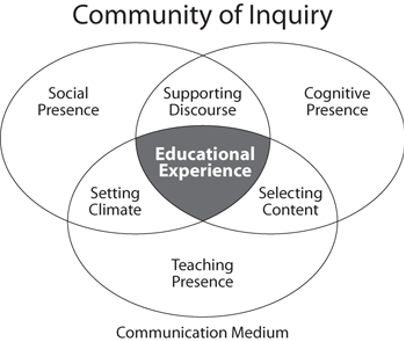Just as good teaching in face to face contexts involves the application of various theories and theoretical models (whether purposefully or unknowingly), the same applies when teaching online. Recent editions of the CILT newsletter have included discussion of various “presences” related to teaching in online contexts. Three of the presences discussed so far (cognitive, social and teaching presences) are linked to the community of inquiry or COI model.
The COI model provides a framework for online teaching. It suggests teaching and learning in online contexts are more successful and effective where cognitive, social and teaching presences are all included (Cooper and Scriven, 2017). Stemming from the work of Dewey, it considers the absence of what works well in physical classrooms and replicates the missing elements online through the inclusion of cognitive, social and teaching presences.

From: https://coi.athabascau.ca/coi-model/
In practice, the inclusion of the social presence can be as simple as ensuring your students introduce themselves, ideally with photographs, and use the discussion boards. You can also use Collaborate to support online, synchronous discussions. The teaching presence requires your deliberate incorporation of relevant and effective learning activities that are well explained and contextualised and which encourage students to interact. These well considered activities should motivate students to be active in their learning, not passive recipients of content (Anderson, 2017). Students need to do more than just watch a lecture or read a text; they need to engage in an online discussion about the content or complete a task which helps them engage with it. Finally, “Cognitive presence is defined as the exploration, construction, resolution and confirmation of understanding through collaboration and reflection in a community of inquiry” (Garrison, 2007).
Ideally, to ensure all three presences are in play, teaching online should involve you creating an environment where students actively engage with the content you are teaching and have opportunities to reflect on, question and discuss their learning with you and each other. One example of how this might work is: presenting your students with a new set of ideas or concepts which they can then critically think about by conducting their own research (via library databases, exploring other resources, interviews, experiments etc.) and then engage in well planned (by you) online discussions, groupwork, online debates, quizzes or a range of other interactive online activities about how these ideas or concepts apply to real world situations.
References
Anderson, T. (2017). How communities of inquiry drive teaching and learning in the digital age. Retrieved from https://teachonline.ca/sites/default/files/tools-trends/insights/pdf/how_communities_of_inquiry_drive_teaching_and_learning_in_the_digital.pdf
Cooper, T., & Scriven, R. (2017). Communities of inquiry in curriculum approach to online learning: Strengths and limitations in context. Australasian Journal of Educational Technology, 33(4). doi:10.14742/ajet.3026
Garrison, D. R. (2007). Online community of inquiry review: social, cognitive, and teaching presence issues. Journal of Asynchronous Learning Networks, 11(1), 61 – 72.
Written by Dr Ann Luzeckyj
Senior Academic Developer (Teaching Specialist) – CILT

